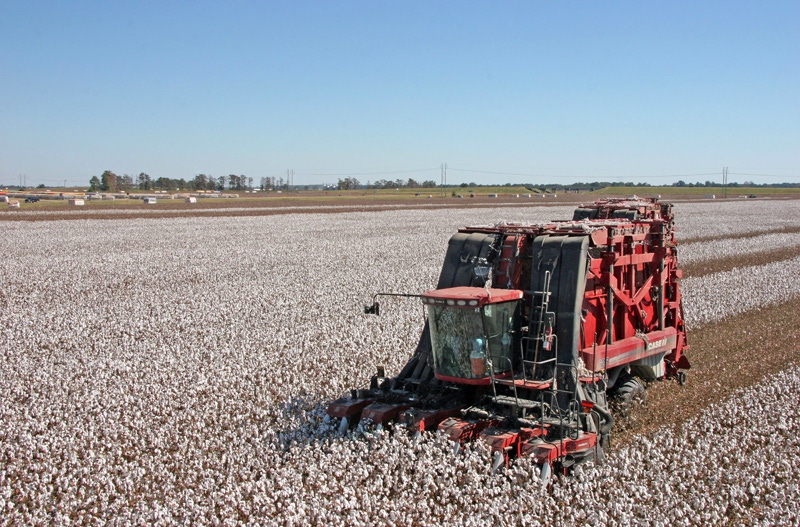January 21, 2019

Dr. Don Shurley says reports that cotton futures may be headed lower — possibly even under 70 cents per pound — could be overblown.
Seventy cents has been an area of technical support for cotton market participants after Intercontinental Exchange March 2019 futures began a months-long descent from closing above 90 cents per pound last June.
“There’s a lot of talk about weakness in this market; of prices dropping below 70 cents,” says Shurley, cotton economist and professor emeritus at the University of Georgia’s Tifton campus. “That talk is not unfounded.
“But the economic fundamentals we face in this market are not all that bad,” he said, speaking during a University of Arkansas System Division of Agriculture Food and Agribusiness Webinar, moderated by the University of Arkansas’ Dr. Bobby Coats Jan. 17. (To watch the webinar, visit https://youtu.be/mot5XacLgSY.)
One of the positives for Shurley is that March 2019 Intercontinental Exchange cotton futures have risen, closing at 73.89 cents per pound on Friday, Jan. 18, after edging closer to 70 cents for much of January. The markets had to shrug off several negative factors to move higher.
“I think more than anything this market is being driven by the uncertainty of things like the trade, the tariff situation, the data, lack of data, and fear of what could happen in terms of our exports,” said Shurley, referring to the ongoing tariff war with China and the government shutdown that has kept USDA from updating its market reporting.
Georgia crop down
The latter means USDA agricultural economists have not been able to confirm the belief of many observers that the 2018 Georgia crop will be down 1 million bales from what USDA projected before Hurricane Michael’s high winds and rains devastated the crop in October.
“USDA actually increased the size of the crop back in its December numbers,” said Shurley. “And that certainly took the market by surprise.”
Georgia’s average yield, which USDA estimated at 980 pounds of lint per acre in its October Crop Production Report, is now expected to be less than 700 pounds per acre. Total production, which USDA forecast at 2.9 million bales in October, could be as low as 1.9 million.
“I talked to an Extension agent in a county that’s very heavily irrigated — and it’s not unusual for irrigated cotton to average 1,200 pounds or more,” said Shurley. “When I asked what he expected the county’s yield would be, he said 300 pounds.
“I said, ‘You’re kidding?” He said, ‘No, we didn’t have hardly anything picked when Michael came through, and it’s done nothing but rain since.’ So that’s further deteriorated the crop, and I wouldn’t be surprised to see the Georgia crop come down just a bit more.”
Crop quality could also be an issue because of the harvest delays in Alabama, Georgia and South Carolina, as well as California. Overall, the U.S. harvest was 7 percentage points behind normal in the last crop progress report issued by USDA.
Smaller foreign crops
Another positive is the USDA’s projection of smaller crops in China, India and Pakistan, which could mean less competition for U.S. cotton exports. “Certainly, that would be beneficial given the tariff situation and uncertainties we have with China.”
On the negative side, USDA’s World Agricultural Outlook Board has reduced its estimate of world cotton consumption for three consecutive months — October, November and December.
“Now these lower estimates are still record,” he said. “But these three consecutive months call us to question whether we can hold the stability of world use. Oil prices are down. Are we going to get into a cotton versus man-made fiber situation as we did for a long number of years?”
While futures prices have been rising in recent days, Shurley said the market will hit technical resistance barriers at the 75-76 cent level and again at 80-81, making it difficult for the market to recover to the 80-cent range.
“I know everybody wants another shot at 80 cents and certainly 85,” he said. “There’s not a cotton grower out there who wouldn’t say, ‘Man, if we could just make another run back to 80 to 85, then I’ll be happy.’”
Negative factors
What growers need to do, however, is to think about the negative factors, where those could take the market and develop a strategy for dealing with a downturn, Shurley notes.
“Yes, we all want cotton to return to 80 to 85 cents, but if we get up in that 75-, 76-cent area, then maybe we start to let some of the crop go, sell it off in portions. Then, if the market goes down, at least you will have taken something better than what we have now.”
Longer term, Shurley says, growers should be heartened by developments in countries like China, Vietnam, Bangladesh and Turkey where mill use has made strong recoveries since the consumption lows set back in 2011.
“China always gets the news. The current estimate for the 2018 crop year by USDA puts China using 3.5 million bales more than it did at the low point back in 2011. That’s a 9.2 percent increase since 2011.”
Vietnam has increased its usage of cotton almost 6 million bales since the low in 2011, a 350 percent increase. Bangladesh has increased 4.3 million bales for more than a doubling of usage of cotton since 2011. Turkey, among the top five export destinations for the U.S., has increased 25 percent since the 2011 low.
Is China important? “Absolutely,” says Shurley. “But these other countries are also important, and our exports are going to depend on us being able to tap those markets, which we are. Continuing to increase our exports and market share into those countries — particularly since the future in China is unknown with the tariff situation — is crucial.”
For more information on the Food and Agribusiness Webinars, visit www.uaex.edu/ag-webinars.
About the Author(s)
You May Also Like






